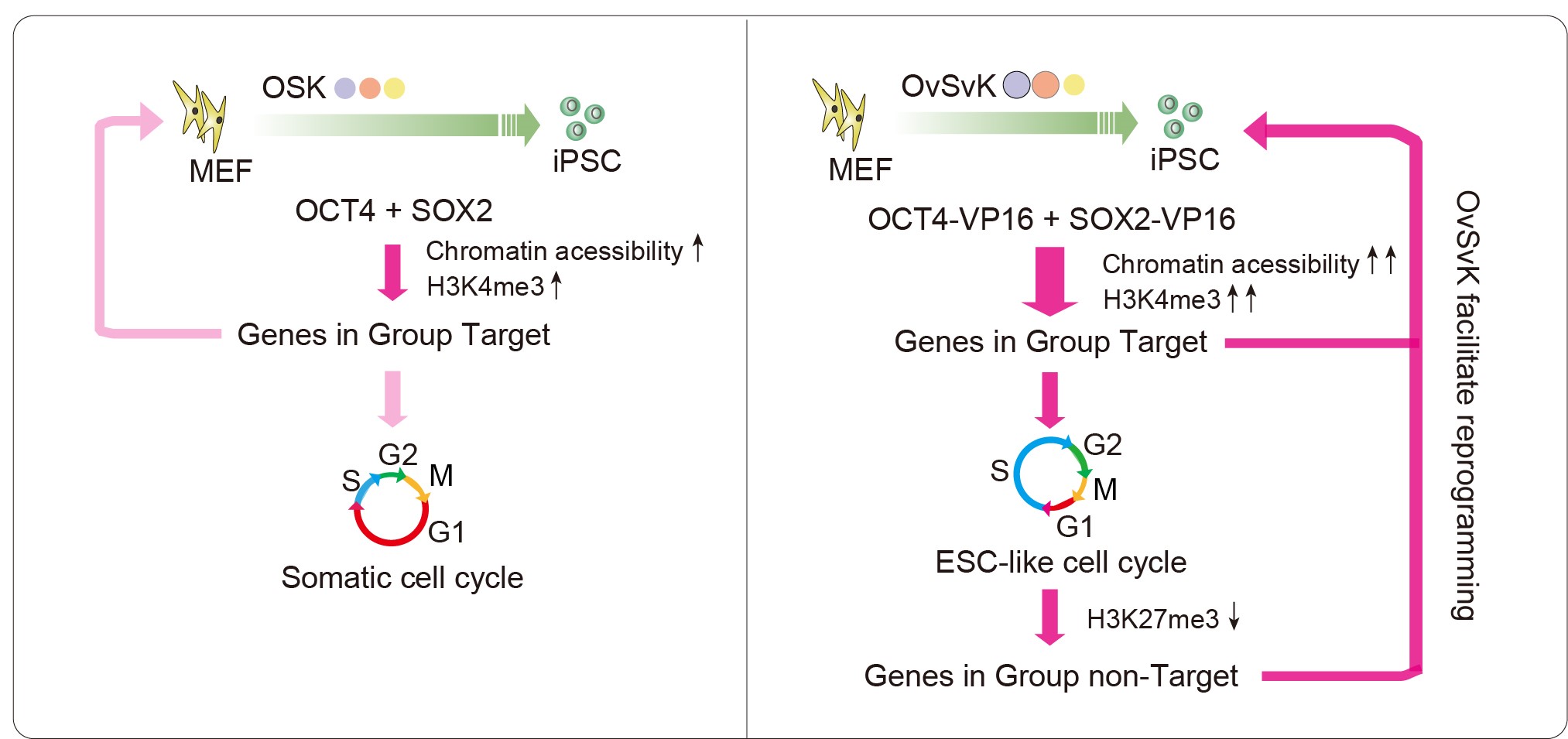Researcher Unveils Novel Mechanism of Cell Fate Regulation via Cell Cycle-Dependent Epigenetic Remodeling
Recently, a research article titled "Enhanced Activities of OCT4 and SOX2 Promote Epigenetic Reprogramming by Shortening G1 Phase" was published in Advanced Science by Dr. ZHENG Hui's team at the Guangzhou Institutes of Biomedicine and Health, Chinese Academy of Sciences. The study reveals a novel mechanism by which cell cycle regulation influences epigenetic modifications to facilitate somatic cell reprogramming into induced pluripotent stem cells (iPSCs), offering new insights into cell fate transitions.
The study constructed enhanced transcription factors by fusing the herpesvirus VP16 activation domain to OCT4 and SOX2, creating the OvSvK complex (OCT4-VP16/SOX2-VP16/KLF4). Compared to classical OSK (OCT4/SOX2/KLF4) combination, OvSvK induced germline-competent iPSCs by day 4 of reprogramming—significantly accelerating efficiency. Single-cell analyses revealed OvSvK restructures the cell cycle, shortening G1 phase while extending S phase to establish an embryonic stem cell-like pattern. siRNA screening identified a complementary combination (CCC): co-overexpressing Ccne1 while suppressing Ccnd1 and Cdkn2a. CCC similarly modulated the cell cycle and accelerated reprogramming, directly validating cell cycle regulation's critical role.
Comparative analysis of OSK and OvSvK systems revealed that genes highly expressed in OvSvK—but not directly regulated by OCT4/SOX2—exhibited reduced H3K27me3 (trimethylation of histone H3 at lysine 27). Notably, these patterns recurred in the CCC system, indicating cell cycle restructuring affects epigenetic heritability. While previous studies established that epigenetic marks require S-G2/M transition for restoration in daughter cell G1 phases, their roles in cell fate regulation was unknown. Using the Fucci system with image-based profiling, the research demonstrated that OvSvK-mediated G1 shortening impedes H3K27me3 restoration, consequently elevating gene expression.
In conclusion, this study reveals that OvSvK accelerates reprogramming through dual mechanisms: VP16 fusion enhances direct OS-target expression, while cell cycle restructuring modulates H3K27me3-mediated regulation of non-OS targets. These findings thus establish cell cycle dynamics as key epigenetic modulators for cell fate transitions, providing fundamental insights into reprogramming mechanisms.
Professor ZHENG Hui from the Guangzhou Institutes of Biomedicine and Health (GIBH), Associate Research Fellow GUO Lin, and Professor PEI Duanqing from Westlake University served as co-corresponding authors of this study, with Dr. GUO Lin being the first author. This research was supported by the National Key Research and Development Program of China, the National Natural Science Foundation of China, Guangdong Province and Guangzhou Municipal Science and Technology Projects, along with the InnoHK Initiative.

Figure: Schematic of the OvSvK reprogramming mechanism (Image by Prof. ZHENG's team).
Contacts:
ZHENG Hui, Ph.D., Principal Investigator;
Guangzhou Institutes of Biomedicine and Health, Chinese Academy of Sciences, Guangzhou, China, 510530.
Email: zheng_hui@gibh.ac.cn
Attachment Download:
-
ContactZHENG Hui, Ph.D., Principal Investigatorzheng_hui@gibh.ac.cn
-
Reference
-
Related Article